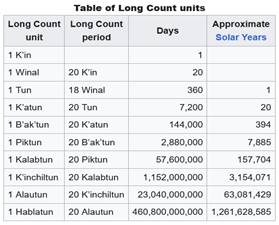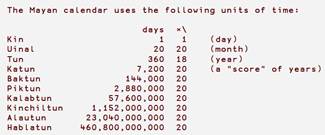· The 5 smallest and most basic units are: K’IN, WINIK, HAAB, WINIKHAAB (katun), PIK/PIH (baktun).
o Unit-1. K’in: 1 day.
o Unit-2. Winik: 20 days.
o Unit-3. Haab: 360 days = 18 winiks.
o Unit-4. Winikhaab/Katun: 7,200 days = 20 haabs:
§ The term k’atun is an elided form of k’al-tuun = the -l- is dropped. [Reference: Tokovinine university lecture, exact reference lost.]
o Unit-5. Pik/Baktun: 144,000 days = 20 winikhaabs/katuns:
§ The term baktun is a completely fictive name with no basis in the glyphs, as the word or root ba- (as an original or corrupted form) meaning “400” is not known in any modern Mayan language – it’s just a convenient term which was adopted in the early years of Maya epigraphy. [Reference: Tokovinine university lecture, exact reference lost.]
These are “standard” for the LC and are given in all of the 5 main pedagogical sources.
· There are 3 higher units – piktun, kalabtun, and kinchiltun – which are not common, but not extremely rare either. All three consist of two KAWAK’s at the bottom. What distinguishes one from another is the elements at the top:
o Unit-6. Piktun: 20 baktuns,
§ The element on top consists of:
· Two scrolls, one to the left and one to the right, resembling a reduced variant of K’AHK’.
· The two scrolls have a single “dotted protector”.
· The element is T42, which has been assigned the code 1G8 by MHD and 0042bv/0042bt by Bonn.
§ The term piktun is a completely fictive name with no basis in the glyphs. However, the motivation behind this name is not known to me.
o Unit-7. Kalabtun: 20 piktuns.
§ The element on top consists of a TZUTZ.
§ The term kalabtun is a completely fictive name with no basis in the glyphs. However, the motivation behind this name is not known to me.
o Unit-8. Kinchiltun: 20 kalabtuns.
§ The element on top consists of a nu and a TZUTZ (or a nu and the reduced variant of AJAW).
§ The term kinchiltun is a completely fictive name with no basis in the glyphs. This name appears to be K’INICH + (suffix) -il (with the suppression of the middle vowel when a trisyllabic word results from compounding or suffixing), but the motivation behind this name is not known to me.
They are given in IC.p16 & K&L.p61. They are not given in K&H, BMM9, 25EMC, EB.
o They are also given in TMHW.pdfp416 along with glyph examples, but kalabtun and kinchiltun are given together, with their glyphs not separated.
o The terms used are not the Classic Maya names but are nicknames given by epigraphers, for ease of reference.
o Usage varies between -tuun and -tun, between k’atun and katun, and between b’aktun, bak’tun, and baktun. It seems quite pointless to attempt to document which sources use which form. I have attempted to standardize to no glottalization marking and short -u- in (-)tun, i.e. piktun, kalabtun, kinchiltun.
· There are even higher units which are extremely rare. As far as I know, only one higher unit – the alawtun – has been given a nickname by epigraphers.
o Unit-9. Alawtun is the highest commonly known unit with a nickname:
§ It’s given on a slide shown in AT-YT2021-lecture23.t0:12:50, as a label for that unit on a drawing of COB Stela 1.
§ This term is given in Gonzalez&Hoppan-TdlMdTeQeeM.p11.pdfp12 as (jun)alaw (no glyph shown in the paper).
§ It’s interesting to observe that the YAX HS2 Step 7 LC has 13 calendar units (see below) – another 5 above kinchiltun:
· “13” was a number of special significance to the Classic Maya, and for many of the higher calendar units, “13” acts in some way like “20” – it’s a moment when something significant changes.
· It’s hence probably no coincidence that there are exactly 13 calendar units in this extended LC expression.
§ Many of the higher units have a HAAB-like element as a component at the bottom.
o Unit-10. Hablatun is the unit immediately higher than the Alawtun. It’s given at the following three sites:
§ https://en.wikipedia.org/wiki/Mesoamerican_Long_Count_calendar

§ https://dfns.dyalog.com/n_mayan.htm:

§ https://sites.google.com/site/largenumbers/home/1-2/1-2-4-the-mayan-numerals: For reasons that we can only speculate the Mayans wanted to go even further. Sir J. Eric Thompson has theorized that originally the Mayans had used a 13 Baktun cycle, but when they wished to continue beyond this point, they created a 20 Baktun cycle instead, to fit in better with their numeration system. Thus the Mayans created 4 more units beyond the Baktun, each 20 times greater than the previous one. We do not know the original names of these units, but Mayanists have traditionally used the terms Piktun, Kalabtun, K'inchiltun, and Alawtun, with some variations in spelling (For convenience I'll use these terms as well). There are some inscriptions that suggest that the Mayans went even further than this, though there are no official terms for units past the Alawtun, though the term Hablatun has been used for the unit just above the Alawtun.
· For the higher calendar units, there is the puzzling question of whether there is a factor of 13 or 20 as one goes from one unit to the next higher one. This is because of the fact that for the longer LC’s, the latest creation date (4-Ajaw 8-Kumk’u) is written as … .13. … .13.13.13.0.0.0.0, where we might instead expect … .0. … .0.0.0.0.0.0.0, based on a (naïve and) strict mathematical understanding of the Maya calendar system. This suggests that 13 behaves in some ways like 0, which in turn suggests that the multiplication factor is 13 instead of the expected 20.
· This question is discussed from different points of view (including the “End of the World” in 2012) in the following papers:
o Stray-13Bv20B: a 43-page paper that reaches the conclusion that there were two different cycles, with a factor 13 and a factor 20, so both are in fact true.
o Stuart-TEDoCS5: a very short paper on the Coba Stela 5.
o Gronemeyer&MacLeod-WCHi2021: a 68-page paper on TRT Monument 6.
·

Montgomery = Coll-1
YAX HS2 Step 7 I1-O1
Extended LC = 13.13.13.13.13.13.13.13.9.15.13.6.9 (see below for individual unnamed units and elsewhere in the CMGG for the named ones)
![]()
![]()
![]()
![]()
![]()
![]()
![]()
![]()
![]()
![]()
Montgomery = Coll-1 Montgomery = Coll-1 Montgomery = Coll-1 Montgomery = Coll-1 Montgomery = Coll-1
YAX HS2 Step 7 K1 YAX HS2 Step 7 J2 YAX HS2 Step 7 I2 YAX HS2 Step 7 J1 YAX HS2 Step 7 I1
13.<?:K’AN:HAAB?> 13.<?:NAL:HAAB?> 13.<IXIIM?:HAAB?> 13.<<<?:?>.IXIIM?>:HAAB?> 13.<WITZ’?:HAAB?>
alawtun hablatun - - -
Unit-9 Unit-10 Unit-11 Unit-12 Unit-13
1 unit above kinchiltun 2 units above kinchiltun 3 units above kinchiltun 4 units above kinchiltun 5 units above kinchiltun
![]()
![]()
Looper-LW.p125.pdfp138.fig4.5 Looper-LW.p125.pdfp138.fig4.5
QRG Stela A D1 QRG Stela F D13
19.<<higher-calendar-unit>:●> <MIH:li>.<<5?.K’AN>:HAAB:NAL:<la/●>>
0 alawtun 0 5? alawtun
· The unit in QRG Stela A D1 is one with a “HAAB” at the bottom. It appears to have a bird-head at the top. YAX HS2 Step 7 I1 (= Unit-13 = 5 units above kinchiltun) also appears to have a bird-head infixed in the top. However, it’s not clear if these two are the same unit because it’s unclear if it’s the same element infixed. They could be, or one might BIH-like (4 dots at the ends of an “X” equally spaced around a circle) and the other might be HA’-like (“dot necklace” below a circle). On the other hand, they might both be the Waterlily Serpent – there’s a variant of the Waterlily serpent with HA’ infixed in the head, and another with a sort of “bow” or “knot” infixed the head, which might be YAX HS2 Step 7 I1 and QRG Stela A D1, respectively.